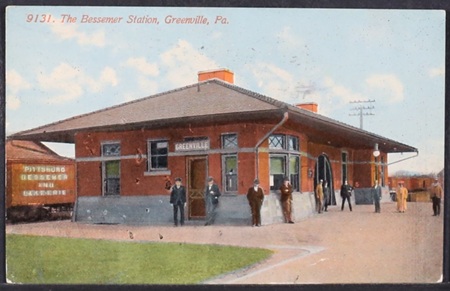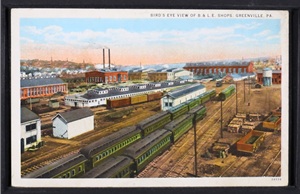|
MERCER COUNTY PAGenWeb Project |
| B. & L. E. ROAD IS TOWN'S PRIDE Greenville, Pennsylvania | ||
 The Bessemer Station Greenville | The
Bessemer & Lake Erie Railroad, as the term is generally applied to
that system, has had a number of names. It was first known as the Bear
Creek Railroad Company and organized March 20, 1865. |  B & L.E. Railroad Shops Greenville |
| The
name was changed to the Shenango & Allegheny on April 9, 1867.
It first began regular operation in Oct. 1869, the line extending from
Shenango, where it connected with the Atlantic & Great Western, to
Pardoe where it tapped the coal deposits. By July of 1872, the
line had been pushed on to Harrisville and by Jan. 6, 1876, Hilliards,
Butler County, was the southern terminal. The road was extended to
Greenville, March 11, 1882, the station being located on Clinton street
practically the same site as the present station. Then, on Jan. 12, 1888, the corporate title was changed to the Pittsburgh, Shenango & Lake Erie Meanwhile, the Ohio River & Lake Erie Railroad Company had been organized, November 23, 1881, and was succeeded by the Erie, Shenango & Pittsburgh Railway Company on June 5, 1886. These corporation were merged June 5, 1888, with the Pittsburgh, Shenango & Lake Erie. The same year as the above consolidation, Feb. 16, the Northeastern Ohio Railroad Company was formed securing the right-of-way into Conneaut Harbor and another Pittsburgh, Shenango & Lake Erie took over the former corporation of the same name and the Northeastern Ohio Company. This was by agreement made June 8, 1888, and in September of that year the line extended from Clinton Street, Greenville, to Osgood where connection was made with the Lake Shore and Michigan Southern. Extending south from Butler to East Pittsburgh, the same interest organized on April 8, 1896, the Butler & Pittsburgh Railroad Company. The Pittsburgh, Bessemer & Lake Erie Company came into corporate being Dec. 22, 196, by a consolidation of the P.S. & L. E. and the Meadville, Linesville road. The line from Butler to East Pittsburgh was ready for business Oct 22, 1897. One of the most stirring times in the development of this railroad began Dec. 31, 1900, when the Bessemer & Lake Erie Railroad Company was formed. At that time, and possibly now, the Pennsylvania law prohibited the paralleling of existing railroad lines. The need of a better grade for its rapidly increasing freight traffic was felt to be imperative. The line through Greenville was sinuous and there was a heavy grade from Shenango to Kremis. There was scarcely room for a second track and the difficulties of moving large freight trains through Greenville and the narrow valley between Greenville and Osgood made a new double track line impracticable. It was decided to build a new line, for freight particularly, from just north of Osgood to Kremis. To build this line a new company was organized and the road built. The line from K. O. Junction to Kremis is the actual physical Bessemer & Lake Erie and all the rest of the system is the Pittsburgh, Butler & Lake Erie which it acquired by lease and to this day leases and operates the P. B. & L. E. system. Another instance of the “tail wagging the dog.” The first operation of the K. O. Line, as it is called, began in September 1902. There had been an ore train over the line as early as April 28 of that year. The Bessemer has always been a “home road” and its fortunes closely linked with those of Greenville from the day it opened until the present time. For many years its modest operating offices were in Greenville, at one time they included a few rooms in the second floor of what is now the T. C. Gibson and Son building. J. T. Blair who had made some reputation as a railroad executive on a small railroad in the oil regions was made superintendent, later general manager, of the S. & A. and was a notable figure in Greenville, a man of unusual personality and ability. In addition to the superintendent’s office there were those of general passenger agent, I. D. Stinson. This road was small and there were few departments, but many duties. The road was continually in hot water financially and “When do we get our pay?” was as frequently heard among the railroad men here as it was at Kimberly Rolling Mill. The ups and downs of ADD..BESSEM & L.E. …..the early years of the S. & A. and P. S. & L. E. would fill a volume. After innumerable downs there would be an up, and in the main the curve was upward but slowly. At a later period, the offices were moved to the First National Bank building and among the early officials were William Waugh, secretary and treasurer, William G. Sargent and E. D. Comstock, general passenger agents; W. H. Garrett, general freight agent; M. L. Osterhout, chief train dispatcher; and Daniel Moore, treasurer. The legal department was conducted by A. F. Henlein and E. S. Templeton, rising young lawyers here. The former afterwards relinquished his connection, but E. S. Tempelton remained with the company under its various names until a few years ago, holding the title of assistant general counsel for most of that long period. Mr. Blair, after a long career, relinquished his connection with the Bessemer to become manager of the Colorado Northwestern, and later of the Kanawha and West Virginia with offices in Pittsburgh. He was succeeded by John S. Matson, who received the title of general superintendent, coming to the Bessemer from the Erie railroad and was an important figure in the development of the Bessemer in its later and happier days, remaining here until he reached the retirement age. During most of the trying days, Colonel S. B. Dick of Meadville was president of the company. Dick, a Meadville banker and a congressman at one time, was an able financier; indeed, he had to be, and the first real sunshine broke through the dark clouds when Dick and others succeeded in interesting Andrew Carnegie. The canny Scotchman saw the possibility of owning a railroad from his mills to Lake Erie and he bought control of the road. Overnight the stock of the P. S. & L. E. became valuable. With the immense traffic the Carnegie Steel Company could furnish its possibilities as a first-class freight line which were apparent to the most casual observer. Carnegie sold his subsidiary company first class steel rails for the line and also bridges. The railroad became a busy thoroughfare in which Carnegie’s master coup was his formation of the United States Stell Corporation or rather making some moves which convinced the J. P. Morgan interests that it would be advisable to form such a gigantic steel company and buy out the Carnegie interests. And thus, it was that the little coal road from Shenango to Pardoe eventually became what it is today, the backbone or at least a good many of the vertebrae of the United States Steel Corporation. In normal times it carries more freight tonnage than any of the largest and most noted railroad of America, and its earnings, also speaking of normal times, are right up at the top of the list among all the railroad lines of the United States. Greenville received a real impetus when the little shops at Shenango were superseded by new and sizeable shops at Greenville. A subscription campaign was successfully terminated at an enthusiastic meeting in Reiss & Son’s cigar store, although the location didn’t hinge on money soley. If it was an investment, it was a good one. There were many loyal workers in this effort and the town was fortunate to have at lest one “friend at court,” the road’s counsel here, E. S. Templeton. Out of this modest beginning have grown the great shops of the company in Greenville, then which there is said to be no better in the world. It has become our largest industry and prime factor in the growth and stability of Greenville. At the moment, the new roundhouse, the last word in construction and efficiency, is receiving the completing touches. (Source: Frank Booth scrapbook) | ||
| Return to Mercer County Home Page |